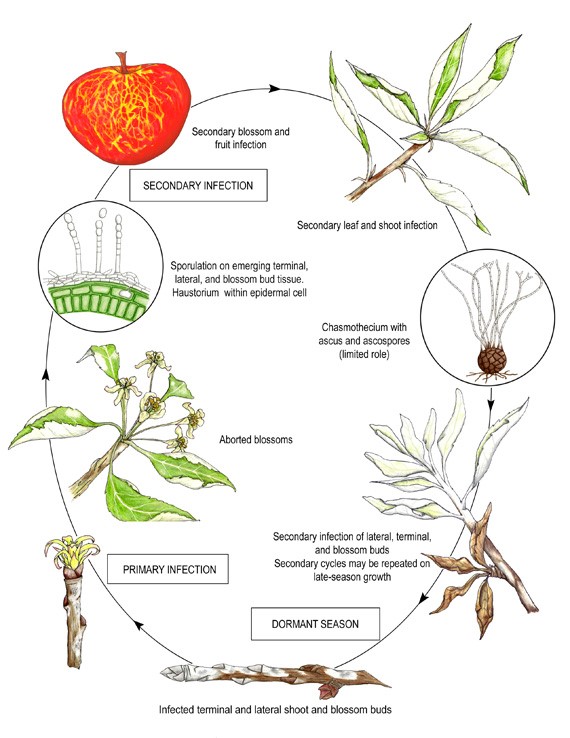Powdery Mildew Control in Apple Orchards
March 19, 2020
Background
Powdery mildew of apple is caused by the fungus Podosphaera leucotricha (a different species than those that cause powdery mildew on cherries, grapes or hops). The characteristic sign of this pathogen is the fuzzy white/gray patches of mycelium, typically found on the undersides of leaves, although the pathogen can infect buds, twigs, blossoms, and fruit as well (especially under high disease pressure). Infected foliage tends to be brittle, leaves tend to be curled and distorted, and terminal shoots that are severely infected will be stunted. On the fruit, russeting may be observed where infection occurred. In general, powdery mildew reduces photosynthesis, reduces shoot growth, and can reduce fruit set and quality.
Conditions Leading to Powdery Mildew
Environmental conditions that are favorable to powdery mildew in apples are mild and dry weather, i.e. temperatures between 66 oF and 76 oF with limited precipitation, which are common in the Pacific Northwest in the spring and early summer. (Note that temperatures below 50 oF or above 86oF will hinder powdery mildew disease development). Because the fungus overwinters in buds infected during the previous season, it is present and ready to initiate powdery mildew disease as soon as conditions are conducive. Therefore, it is important to have a control strategy in place and deploy it when conditions are conducive vs. waiting to treat once signs and symptoms of powdery mildew become apparent. This is especially true in orchards of susceptible varieties such as Honeycrisp, Pink Lady and Granny Smith.
Control of Powdery Mildew
Control of powdery mildew is accomplished with: i) fungicides from one or more of FRAC groups 3 (DMI fungicides), 7 (SDHI fungicides), 11 (QoI fungicides), and 19 (polyoxins), ii) sulfur-based products, iii) biopesticide products, iv) potassium bicarbonate products, and v) mineral oils. However, in organic production only group 19 fungicides, sulfur-based products, biopesticide products, potassium bicarbonate products, and mineral oils can be used.
Potassium bicarbonate products work by: i) increasing pH of leaf surfaces which hinders spore germination, ii) increasing the osmotic potential around fungal spores drying them out, iii) and destabilizing cell membranes. Kaligreen is a potassium bicarbonate product with enhanced effectiveness because it has a proprietary surfactant system that forms contact liposomes. The contact liposomes have a great affinity for fungal cell walls, increasing contact between the potassium ion and the powdery mildew pathogen, which results in greater efficacy of the product.
A typical spray program for controlling powdery mildew in apple orchards involves five sprays, four in the spring and one post-harvest in the fall. The spring applications should begin at bud break and follow with three additional applications at 10–14-day intervals or until production of new shoots has ceased. A fall application should be made post-harvest as well, to reduce the inoculum load of the powdery mildew pathogen for the following year, especially in a high-pressure year. Kaligreen is an excellent choice in rotation with other fungicides for control of powdery mildew, especially in organic orchards. Also note that at temperatures over 80 oF, it Kaligreen should be preferred to sulfur-based products because sulfur-based products are phytotoxic at those temperatures.
Recommendations: Foliar-applied with a non-acidifying spreader/sticker and/or a non-phytotoxic oil.
- 3 lb/ac of Kaligreen for powdery mildew control.

Source: apsnet.org
